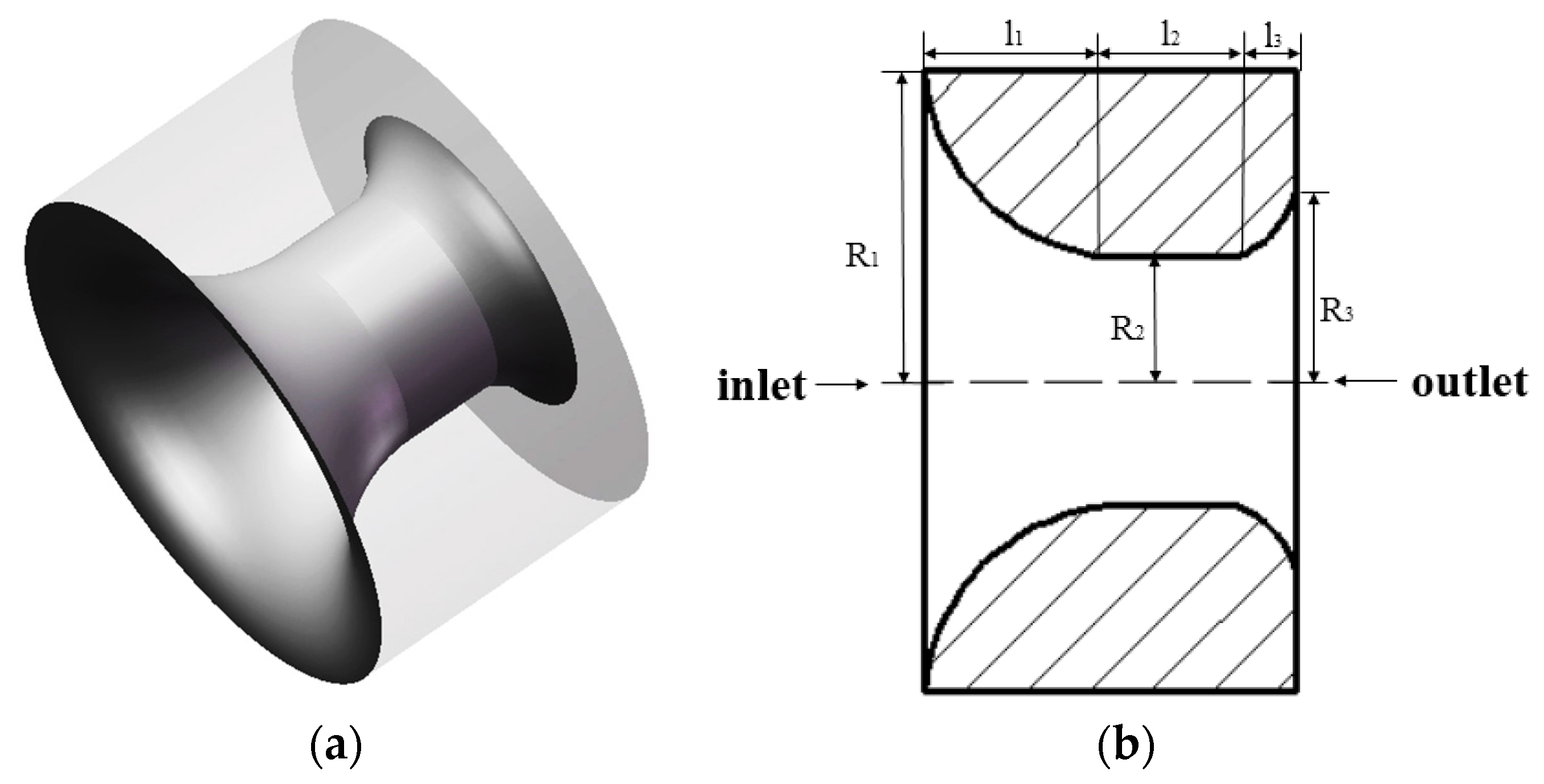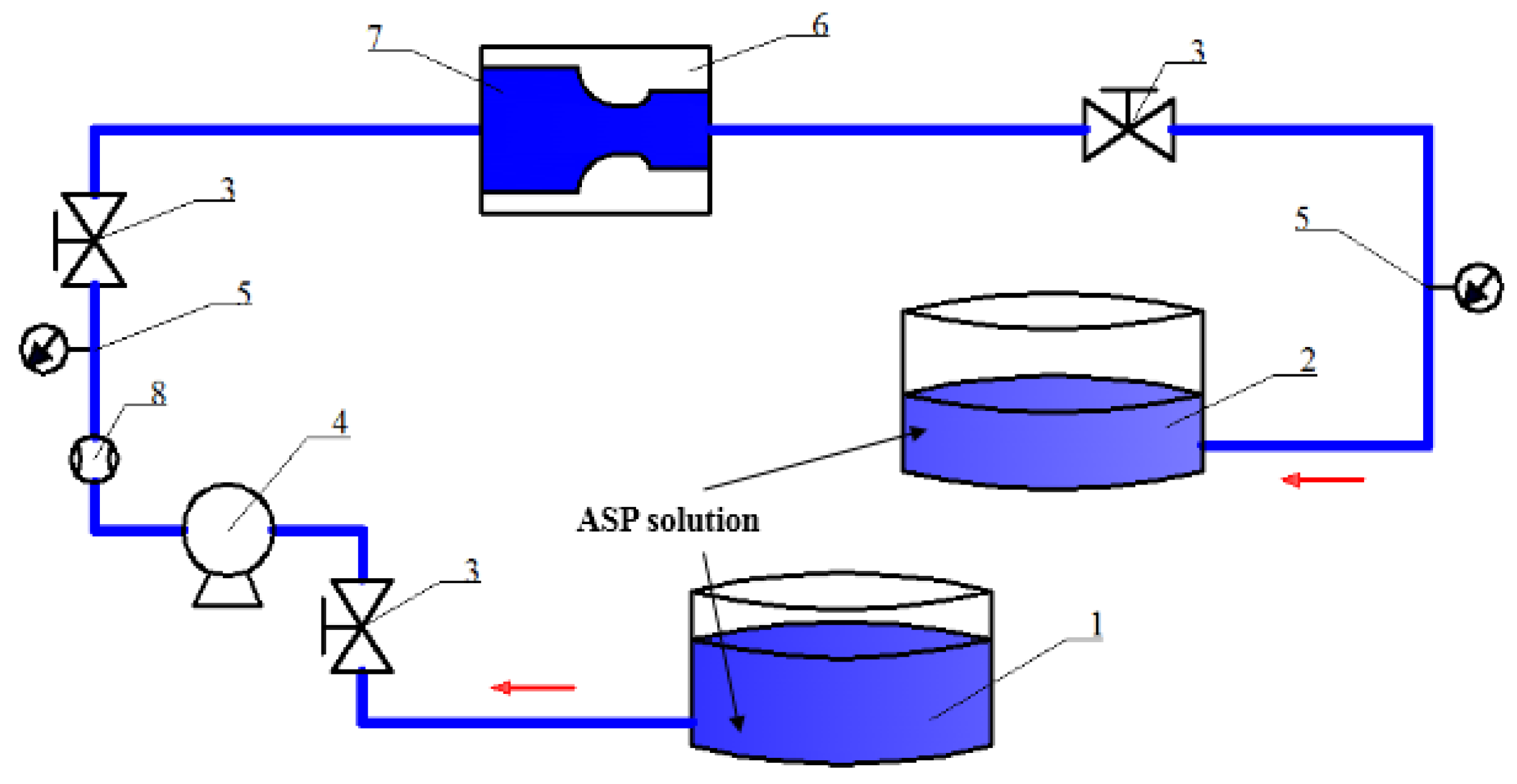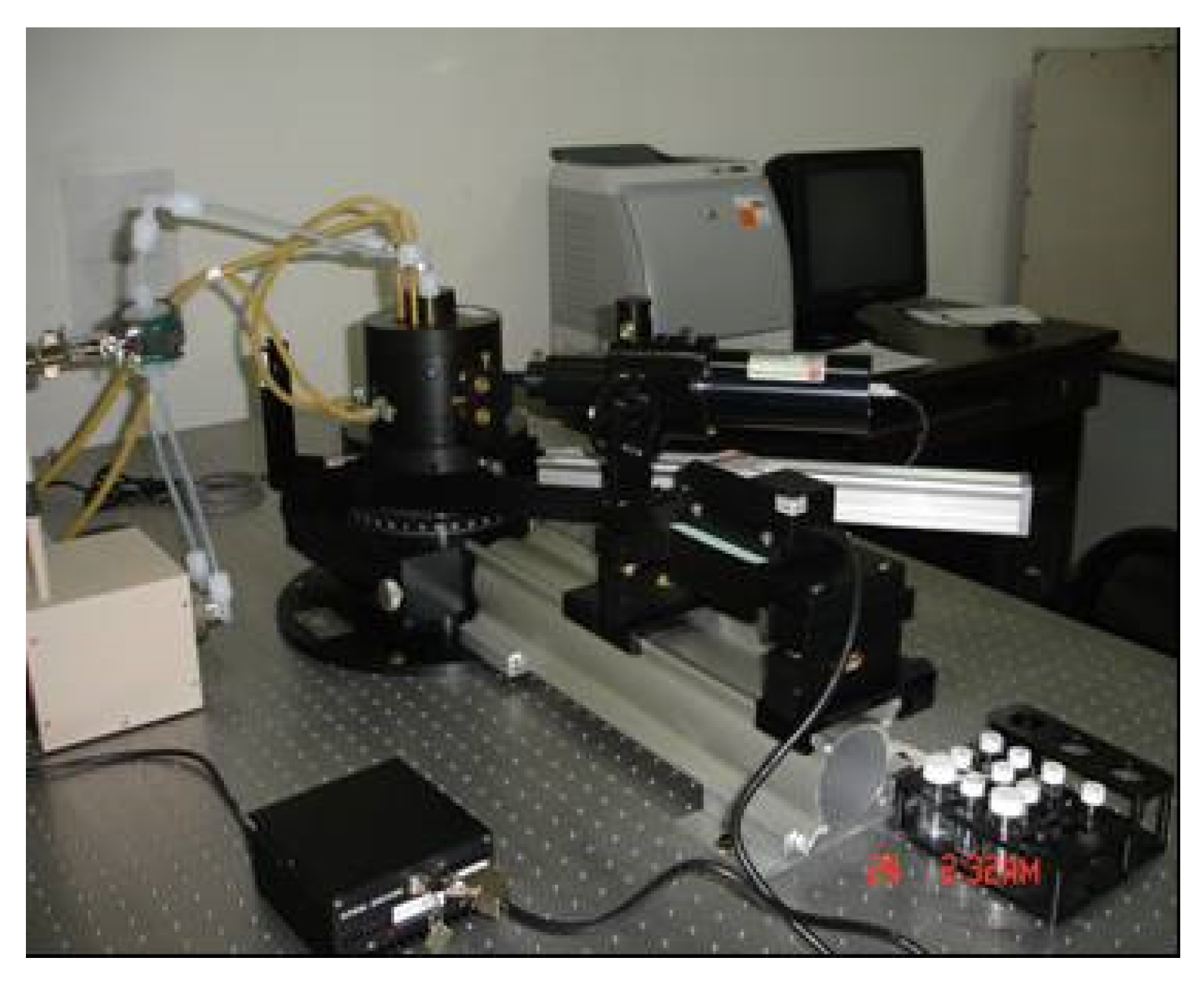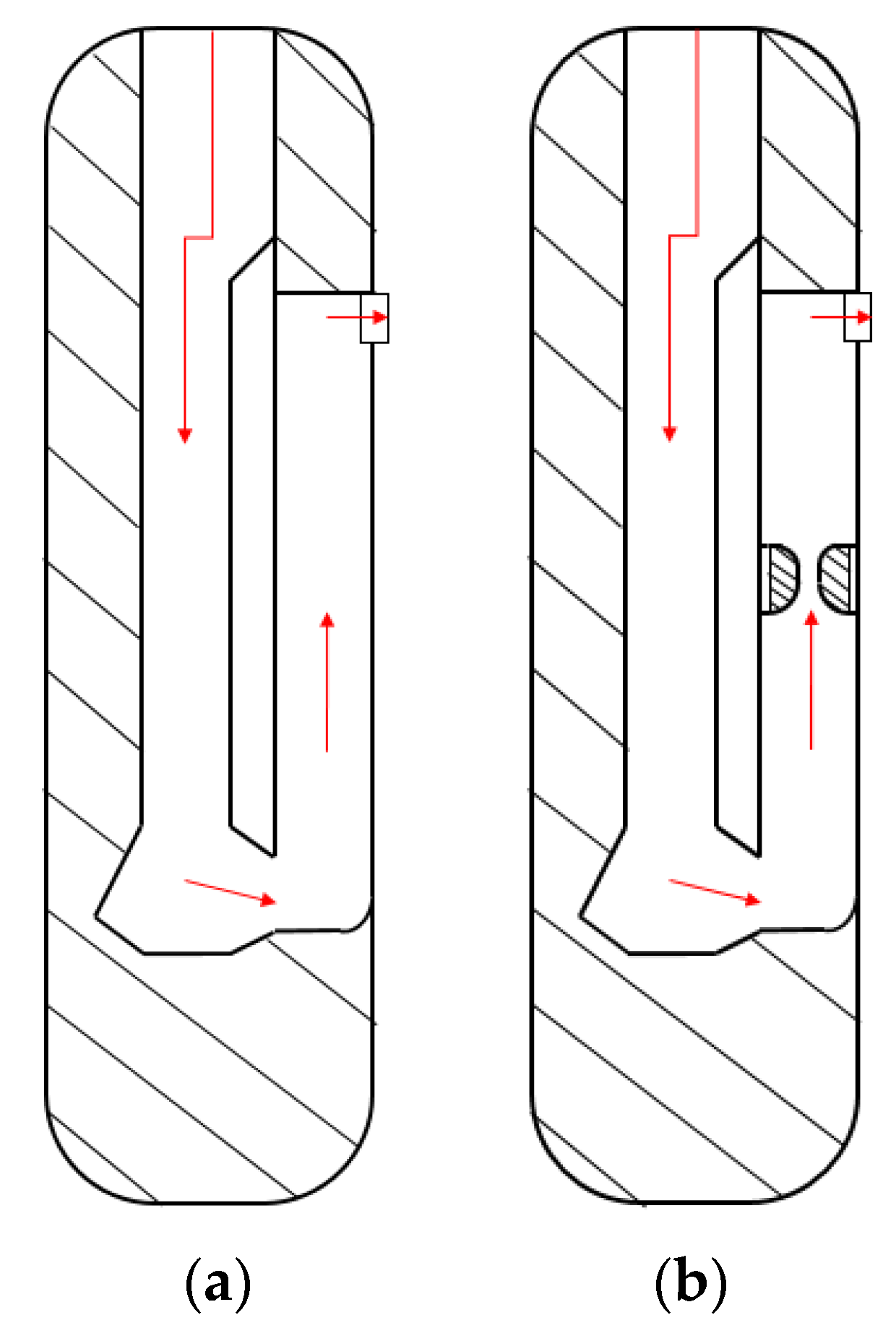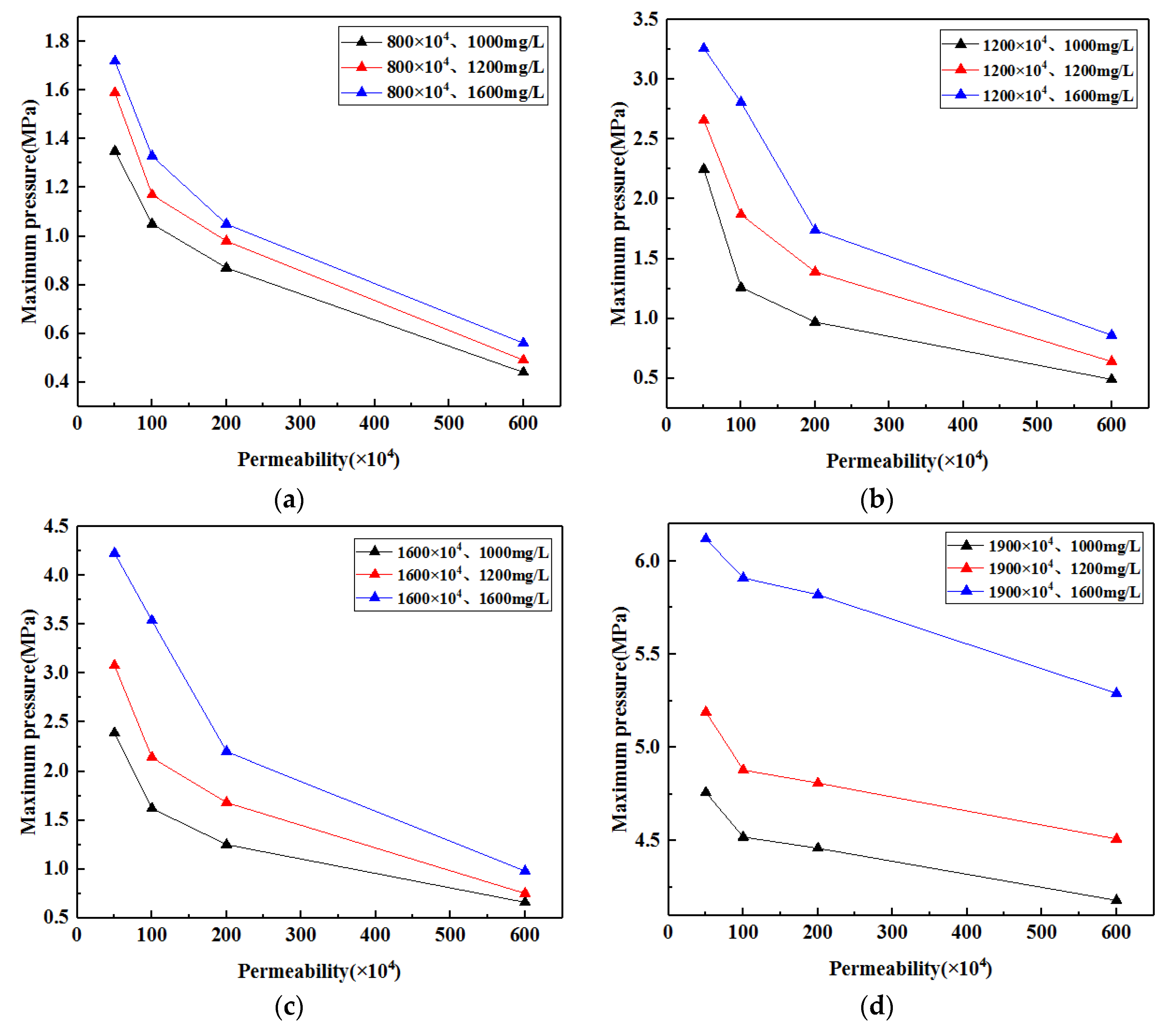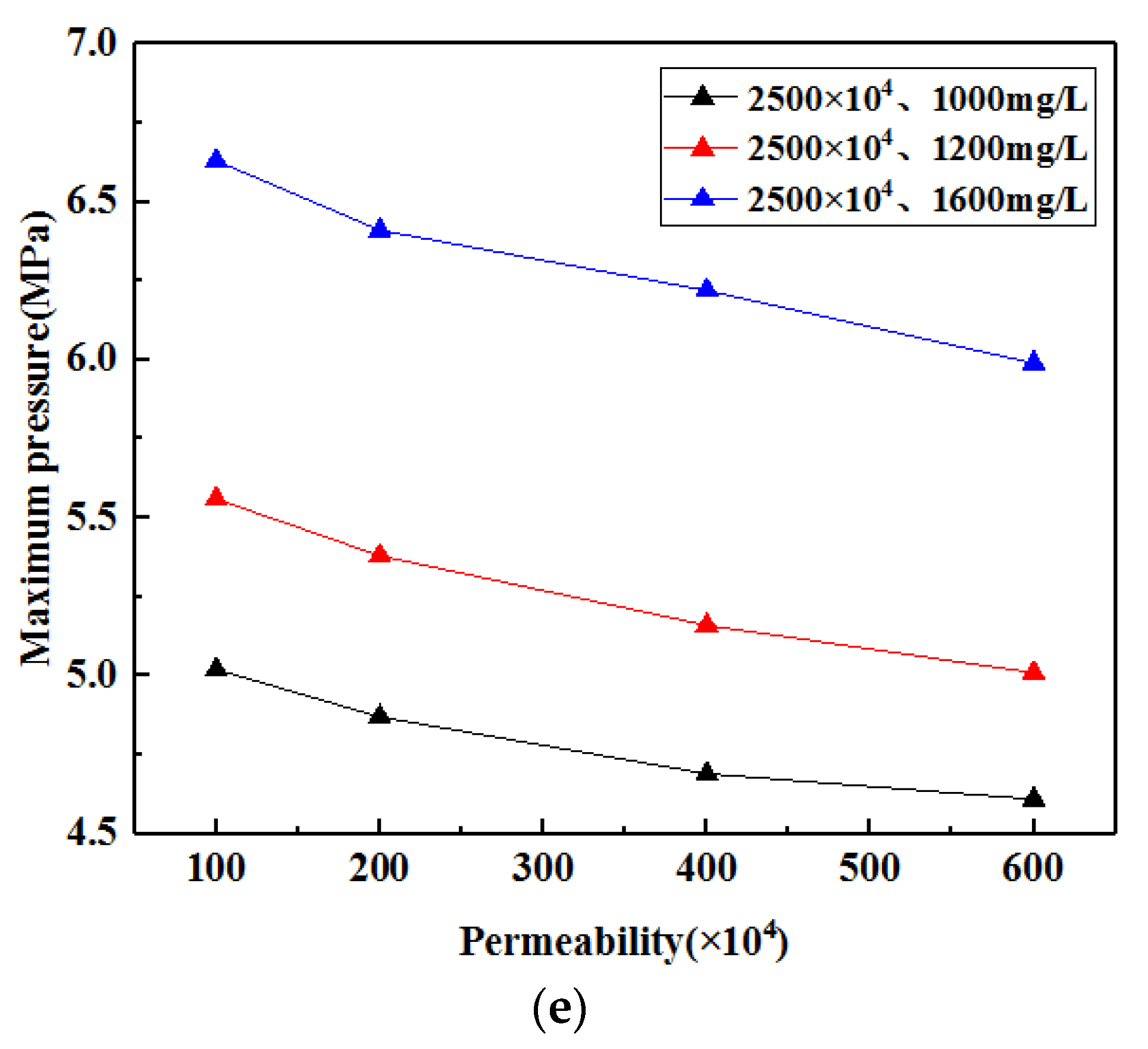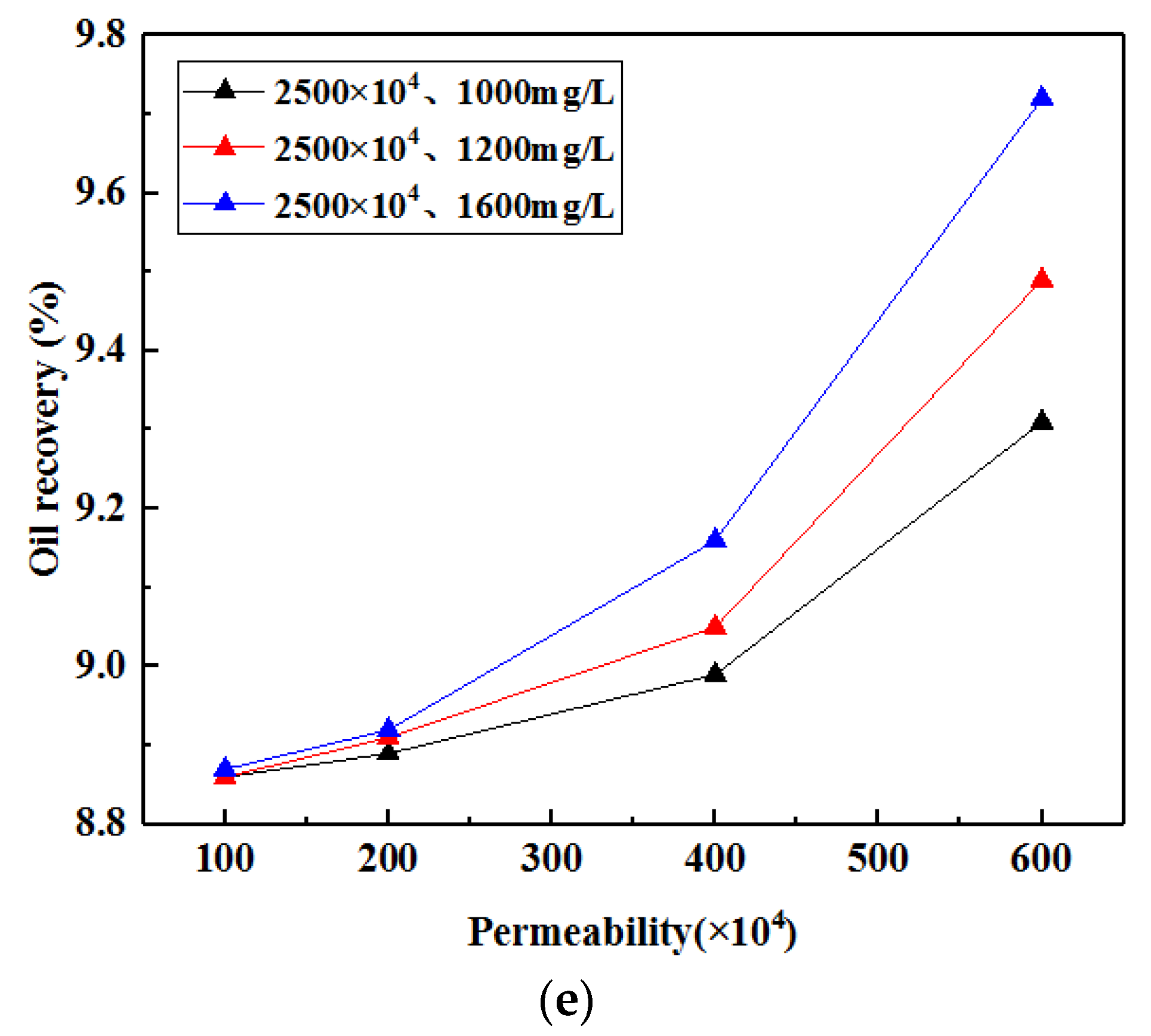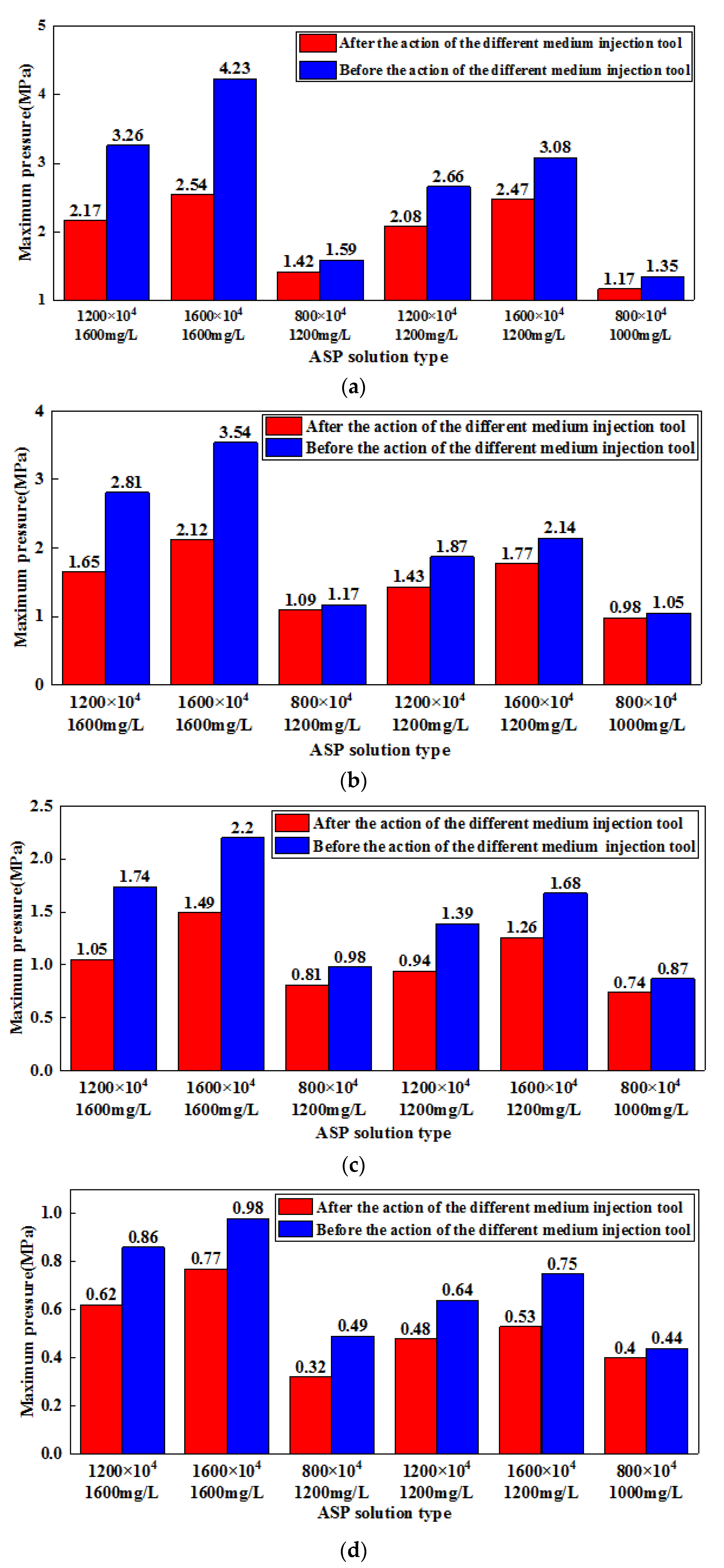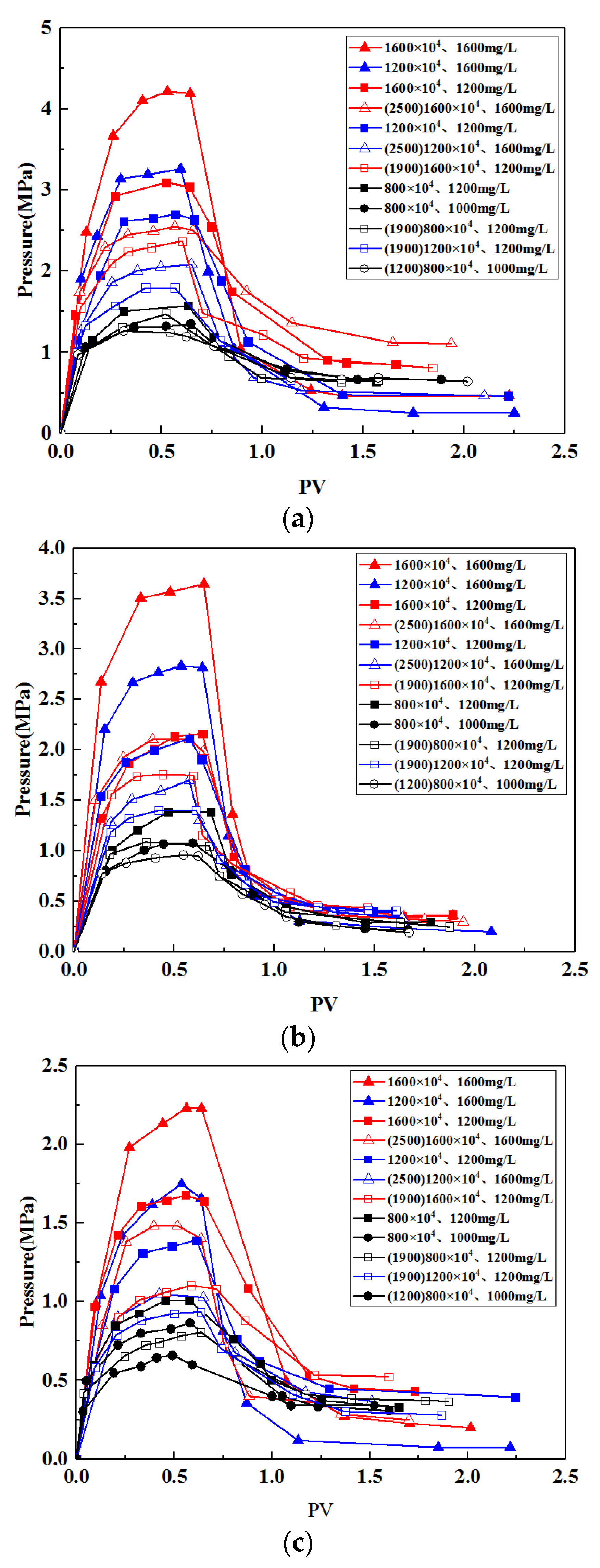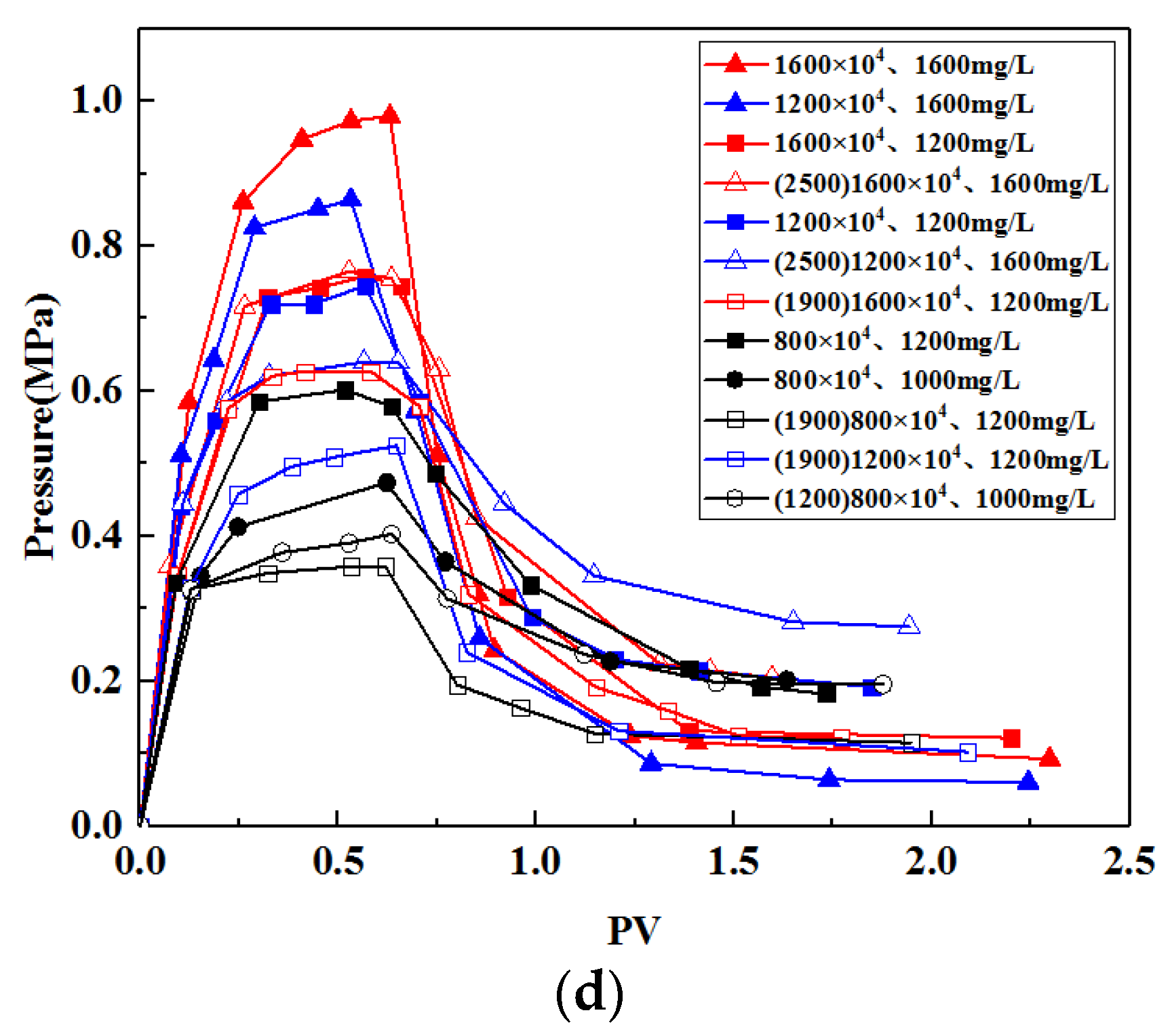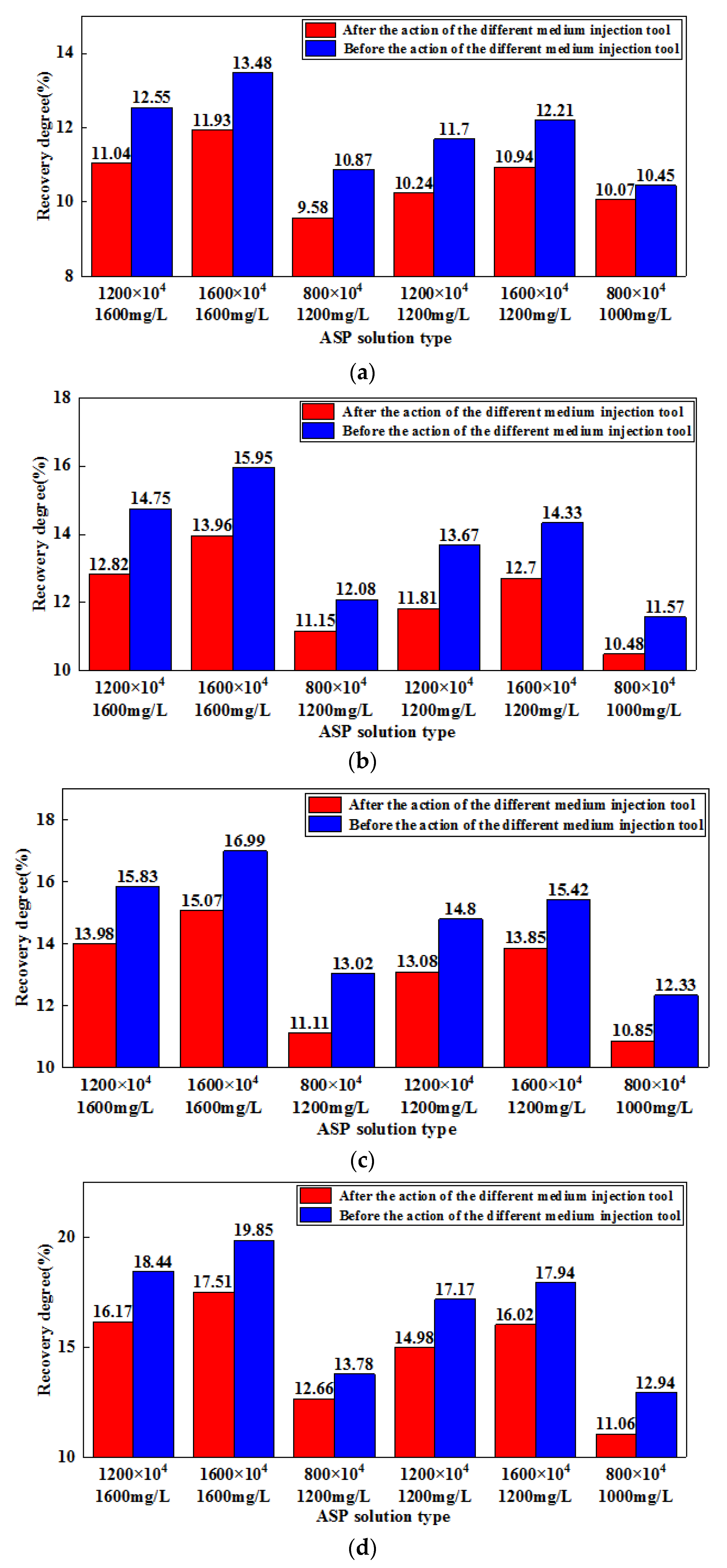3.1. Study on the Matching Relationship between the Molecular Weight of the ASP Solution and Core Permeability in the Oil Displacement Experiment
The core displacement experiment was carried out without the use of the partial quality tool. The experimental process is shown in
Figure 4, and the relationships among different ASP solutions and the maximum injection pressure and oil recovery were obtained, as shown in
Figure 6 and
Figure 7.
As can be seen from
Figure 6, with the increase of core permeability, the maximum injection pressure of the ASP solution decreases. This is because the larger the core permeability is, the larger the pore volume of the core is, the larger the flow surface of the ASP solution in the core is, the smaller the flow resistance is, and the stronger the injection capacity of the solution is. Therefore, the less injection pressure required, the lower the maximum injection pressure will be [
23].
With the increase in the solution concentration, the maximum injection pressure increases. This is because with a higher solution concentration, larger molecular coils will be generated between molecules and more polymers will stay or even block the pore channels, causing difficulties in the injection of the ASP solution, resulting in an increase in the injection pressure. With the increase of the molecular weight, the maximum injection pressure increases. This is because the larger the molecular weight of the polymer is, the larger the effective volume of the molecule in the solution is, and the larger the amount of adsorption and capture in the core are. The obvious permeability reduction effect occurs, resulting in a decrease in the injection capacity. The required injection pressure increases, and the maximum injection pressure correspondingly increases [
24]. However, when the molecular weight reaches 1900 × 10
4 and 2500 × 10
4, the maximum injection pressure reaches 6.12 and 6.63 MPa, respectively and the minimum is 4.18 and 4.61 MPa, respectively, with the change of concentration, which are both very-high pressure values, and with the increase of permeability, the maximum injection pressure decreases to a lesser extent. This shows that ASP solutions with molecular weights of 1900 × 10
4 and 2500 × 10
4 have a poor injection ability with low and medium permeability and a low matching degree to the oil layer, and the effect of changing the solution concentration to change the injection ability of the polymer ASP solution is not obvious.
As can be seen from
Figure 7, with an increase in core permeability, the oil displacement effect of the ASP solution is better, and the oil recovery is higher. This is because the higher the core permeability, the larger the pore volume, and the larger the volume of ASP solution entering the core pores, the better the oil displacement effect is. The higher the concentration of the ASP solution, the higher the oil recovery is. This is because the higher the concentration of the solution, the denser the arrangement of polymer molecules, the tighter the overall network structure, the more molecules per unit volume, the greater the viscosity, and the better the oil displacement effect in pores. The higher the molecular weight is, the higher the oil recovery is. This is because the higher the molecular weight, the longer the molecular weight, the easier the molecular weights tangle with each other, the coarser the molecular structure, the higher the viscosity of the solution, and the better the oil displacement effect [
25]. However, with the increase of core permeability, ASP solutions with molecular weights of 1900 × 10
4 and 2500 × 10
4 have little change in oil recovery, and the change in concentration has little effect on the oil recovery. The oil recovery changes only by 9.93–11.52% and 8.86–9.72% respectively, and the oil displacement effect of the ASP solution with a molecular weight of 2500 × 10
4 is lower than that of ASP solution with a molecular weight of 1900 × 10
4, which indicates that the matching degree of polymers in low and medium permeability reservoirs is poor and greatly affects the oil displacement effect.
A comprehensive analysis of the core permeability and the influences of different ASP solutions on the maximum injection pressure and oil recovery showed that when a high molecular weight ASP solution is used for oil displacement, the oil displacement effect is better in high permeability reservoirs, but when it flows into medium and low permeability reservoirs for oil displacement, ASP solutions with molecular weights of 1900 × 104 and 2500 × 104 have a poor injection ability and low oil recovery for low and medium permeability reservoirs, and the improvement of oil displacement effect is not obvious when the concentration is changed. Therefore, for high molecular weight (>1600 × 104) ASP solutions, a partial quality tool is used to improve the oil displacement effect of medium and low permeability cores.
3.2. Influence of the Partial Quality Tool on the Molecular Weight of the ASP Solution
In order to improve the oil displacement ability of the polymer ASP solution in cores with medium and low permeability, the shearing action of the polymer ASP solution (>1600 × 10
4) was carried out by using a partial quality tool to break the polymer chain, reduce the molecular weight, and improve the injection ability. According to the research in the above section on the matching relationship between the molecular weight of the ASP solution and core permeability, it can be seen that the concentration change has no obvious effect on the injection capacity and oil displacement effect of high molecular weight ASP solution in medium and low permeability cores. In order to facilitate an experimental comparison after the action of the partial quality tool, three ASP solutions with reduced molecular weight and concentration were selected respectively, that is, an ASP solution with a molecular weight of 2500 × 10
4 and a concentration of 1600 mg/L, one with a molecular weight of 1900 × 10
4 and a concentration of 1200 mg/L, and one with a molecular weight of 1200 × 10
4 and a concentration of 1000 mg/L. The experimental design used different flow rates (20, 30, 40, and 50 m
3/d), and different ASP solutions were sheared under the actions of different structural parameters (contraction radius 3, 4, and 5 mm) and the average molecular weight of the solution was measured by a laser light scattering instrument. The results are shown in
Table 3.
It can be seen from
Table 3 that the smaller the contraction radius is and the larger the flow rate is, the smaller the molecular weight after shearing is. This is because the smaller the contraction radius is, the smaller the flow cross-section of ASP solution in the partial quality tool will be, and the greater the degree of mutation will be, which will strengthen the shearing effect on the solution. With the increase in the flow rate, the velocity gradient of the ASP solution in the partial quality tool will increase, the flow resistance will increase, the shearing effect will also increase, and the more serious the shearing damage to the molecular chain will be, resulting in a decrease in the molecular weight. Additionally, the molecular weight of the 2500 × 10
4, 1600 mg/L ASP solution can reach (1194–2305) ×10
4 after shearing, and the molecular weight of the 1900 × 10
4, 1200 mg/L solution can reach (871–1762) ×10
4 after shearing. The molecular weight of the 1900 × 10
4, 1200 mg/L ASP solution can reach (461–1060) ×10
4 after shearing. This shows that the shearing action of the high molecular weight ASP solution by the partial quality tool is stronger, and the molecular weight decreases to a greater extent. This is because the larger the molecular weight, the longer the molecular chain, the greater the degree of shearing, and the greater the degree of molecular weight reduction [
26,
27].
In the experiment, in order to obtain the molecular weight corresponding to the initial ASP solution after shearing, the molecular weight of 2500 × 104 can be sheared into 1200 × 104 and 1600 × 104; the molecular weight of 1900 × 104 can be sheared into 800 × 104, 1200 × 104, and 1600 × 104; and the molecular weight of 1000 × 104 can be sheared into 800 × 104 by controlling the flow rate and contraction radius, i.e., the molecular weight of the ASP solution can be matched before and after the action of the partial quality tool, which is convenient for comparing the solution properties under the same conditions.
3.3. Influence of the Molecular Weight of the ASP Solution on the Injection Pressure after the Action of the Partial Quality Tool
In order to study the improvement of the core injection ability of ASP solutions with different molecular weights after the action of the partial quality tool, the injection pressure was selected during oil displacement as the verification parameter. According to the influence of the partial quality tool on the molecular weight of the ASP solution, in order to compare the influence of the high molecular ASP solution after shearing with that of the low molecular ASP solution without shearing on the injection pressure, four kinds of artificial cores with permeabilities of (50, 100, 200, and 600) × 10
−3 μm
2 were selected. Under each core permeability, the ASP solution after high molecular weight shearing (shear from molecular weight 2500 × 10
4 to 1200 × 10
4 and 1600 × 10
4; shear from molecular weight 1900 × 10
4 to 800 × 10
4, 1200 × 10
4 and 1600 × 10
4; shear from molecular weight 1200 × 10
4 to 800 × 10
4) and the low molecular weight ASP solution without shearing (molecular weight 1600 × 10
4, 1200 × 10
4, 800 × 10
4) were tested, respectively. By comparing the influences of factors such as the molecular weight of the ASP solution and core permeability on the injection pressure before and after the action of the partial quality tool, the following experimental results were obtained, as shown in
Figure 8 and
Figure 9.
As can be seen from
Figure 8, when the same ASP solution is injected, the maximum pressure of chemical flooding increases gradually with a decrease in permeability. Moreover, the lower the permeability of the core, the greater the maximum pressure of chemical flooding. An ASP solution with a high molecular weight or high concentration has a high injection pressure due to its high viscosity. In particular, when the permeability is 100 × 10
−3 μm
2 or 50 × 10
−3 μm
2, the maximum pressure of chemical flooding is very high, especially for ASP solutions without the shearing action of the partial quality tool, where the maximum pressure of chemical flooding exceeds 4 MPa. At the same permeability, the higher the concentration of ASP solution with the same molecular weight, the higher the maximum pressure. At the same concentration, the higher the molecular weight, the higher the maximum pressure. The reason for this is that at a high concentration or high molecular weight, the viscosity and elasticity of the ASP system increase, and the required injection pressure increases, thus increasing the macro pressure gradient and resulting in an increase in the maximum injection pressure.
For cores with different permeability levels, the ASP solution with a low molecular weight of 800 × 104 has a maximum pressure of 0.44–1.59 MPa for chemical flooding without the shearing action of the partial quality tool and a maximum pressure of 0.32–1.42 MPa after the shearing action of the partial quality tool; the ASP solution with a medium molecular weight of 1200 × 104 has a maximum pressure of 0.64–3.26 MPa for chemical flooding without the shearing action of the partial quality tool and a maximum pressure of 0.48–2.17 MPa after the shearing action of the partial quality tool; and the ASP solution with a medium molecular weight of 1600 × 104 has a maximum pressure of 0.75–4.23 MPa for chemical flooding without the shearing action of the partial quality tool and a maximum pressure of 0.53–2.54 MPa after the shearing action of the partial quality tool.
It can be clearly seen from
Figure 9 that for cores with the same permeability, the chemical flooding injection pressure of the ASP solution without the shearing by the partial quality tool is significantly higher than that of the ASP solution with the same molecular weight and concentration after shearing, and the lower the permeability is, the greater the difference is. The injection pressure order in the chemical flooding stage is as follows: medium molecular weight 1600 × 10
4 system > medium molecular weight 1200 × 10
4 system > low molecular weight 800 × 10
4 system. In the 50 × 10
−3 μm
2 core, the maximum pressure of each system in the chemical flooding stage is higher than 1 MPa. Therefore, for low-permeability cores, the molecular weight of the ASP solution has a great influence on the injection pressure of low-permeability cores. The lower the permeability is, the smaller the pore radius is, and the polymer injection will block the pore channels of the cores, resulting in a higher injection pressure [
28].
As shown in
Table 4, the pressure of the polymer ASP solution after shearing by the partial quality tool is lower than that of the ASP solution without shearing. The higher the permeability of the core, the more obvious the pressure drop after the action of the partial quality tool is. After shearing, the pressure drop of ASP solutions with molecular weights of 2500 × 10
4 and 1900 × 10
4 reached the highest values of 5.22 and 4.03 MPa, respectively, and the higher the molecular weight, the greater the pressure drop after the action of the partial quality tool. This shows that the injection effect of the polymer ASP solution after the action of the partial quality tool is significantly enhanced, and the matching degree to low permeability cores is greater. Therefore, the partial quality tool can obviously improve the injection capacity of the polymer ASP solution and improve the utilization rate of the ASP solution in low permeability cores.
3.4. Influence of the Molecular Weight of the ASP Solution on the Oil Displacement Effect after the Action of the Partial Quality Tool
In order to study the ability of ASP solutions with different molecular weights to enhance the oil recovery of heterogeneous cores after being acted on by the partial quality tool, relevant experiments were carried out to verify. On the basis of the above maximum pressure experiment, the influences of the polymer ASP solution after shearing and the low molecular ASP solution without shearing on the oil displacement effect were studied. The core permeability and ASP solutions with different molecular weights before and after shearing were the same as those used in the above pressure experiments. By comparing the influence of the molecular weight of the ASP solution and the reservoir permeability before and after shearing on the oil displacement effect, the matching relationship between the ASP solution after shearing and the reservoir permeability is determined, and the following experimental results are obtained, as shown in
Figure 10 and
Figure 11.
As can be seen from
Figure 10, oil displacement experiments were carried out with ASP solutions of the same molecular weight and concentration in cores with different permeabilities, and the extent of oil recovery improvement was different. No matter how the molecular weight and concentration of polymer in ASP solution change, the higher the permeability is, the greater the extent of chemical flooding to improve the oil recovery is. This is because the higher the permeability, the larger the pore radius and throat of the core, and the more or higher molecular weight ASP solution that enters the pore volume and expands the sweep volume of the displacement agent; thus, its oil recovery is high. Under the same permeability level, the higher the concentration of the ASP solution with the same molecular weight, the higher the oil recovery of chemical flooding. At the same concentration, the higher the molecular weight, the higher the oil recovery of chemical flooding [
29,
30]. The main reason for this is that when a high concentration or high molecular weight is used, the viscosity of the ASP solution increases, which is helpful for improving the microscopic oil displacement efficiency and the oil recovery in the chemical flooding stage [
31].
For cores with different permeability levels, the oil recovery of chemical flooding for the ASP solution with a low molecular weight of 800 × 104 is between 9.58% and 13.78%, regardless of whether it is sheared by the partial quality tool. The oil recovery of the ASP solution with a low molecular weight of 800 × 104 after shearing by the partial quality tool is between 9.58% and 12.66%, and that without shearing by the partial quality tool is between 10.45% and 13.78%. The oil recovery of chemical flooding for the ASP solution with a medium molecular weight of 1200 × 104 is between 10.24% and 18.44%, the oil recovery for the ASP solution with a medium molecular weight of 1200 × 104 after shearing by a partial quality tool is between 10.24% and 14.98%, and that without shearing by the partial quality tool is between 11.7% and 18.44%. The oil recovery of chemical flooding for the ASP solution with a medium molecular weight of 1600 × 104 is between 10.94% and 19.85%, the oil recovery for the ASP solution with a medium molecular weight of 1600 × 104 after shearing by a partial quality tool is between 10.94% and 17.51%, and that without shearing by the partial quality tool is between 12.21% and 19.85%. Therefore, the ASP solution without shearing action of the partial quality tool has a better oil displacement effect than the ASP solution with the same molecular weight and concentration after shearing action.
As can be seen from
Figure 11, whether it is a high permeability core or a low permeability core, the best recovery degree of chemical flooding occurs with the high molecular weight ASP solution that has not been sheared by the partial quality tool. The higher the molecular weight and concentration, the greater the recovery degree of chemical flooding. The stage oil recovery is in the following order: medium molecular weight (1600 × 10
4) system > medium molecular weight (1200 × 10
4) system > low molecular weight (800 × 10
4) system. However, the experimental results for 50 × 10
−3μm
2 cores change, and the overall oil recovery is still consistent with other permeability cores. However, the oil recovery in the chemical flooding stage of the ASP solution with a high molecular weight and high concentration is similar to that of the 800 × 10
4, 1200 mg/L solution without shear, the 800 × 10
4, 1000 mg/L solution without shear, the 800 × 10
4, 1200 mg/L solution with shear, and the 800 × 10
4, 1000 mg/L solution with shear. This shows that although the ASP solution with a high molecular weight and high concentration has better effects of increasing the viscosity and improving the fluidity. The ASP solution with a molecular weight of 800 × 10
4 after being sheared or not enters more easily into small pores than other high permeability cores, because the pore size in 50 × 10
−3 μm
2 cores is obviously lower than that in other high permeability cores, and the sweep range in 50 × 10
−3 μm
2 cores is larger, which plays a greater role in expanding the sweep volume and further improving the recovery degree in the chemical flooding stage. Therefore, compared with other systems, the recovery degree is similar. Therefore, the oil recovery of the ASP solution with a shearing action of the partial quality tool is lower than that of the ASP solution with the same molecular weight and concentration without a shearing action.
As shown in
Table 5, the oil recovery of the polymer ASP solution with the shearing action by the partial quality tool is greater than that of the ASP solution without shearing. The higher the molecular weight, the more obvious the ability of the partial quality tool to improve the oil recovery is. The chemical flooding recovery of the ASP solution with a high molecular weight (2500 × 10
4) in a low permeability core (50 × 10
−3 μm
2) is only 8.87% at the highest, and the recovery reaches 11.93% after shearing by the partial quality tool. With the increase of core permeability, the recovery after the action of the partial quality tool is higher. The highest recovery of the ASP solution with a high molecular weight reaches 17.51% and the degree of improvement reaches 80.1%. Therefore, the partial quality tool can effectively improve the oil displacement effect of the ASP solution with a high molecular weight.
Based on the above experimental analysis, the matching relationship between the molecular weight and permeability of the ASP solution is obtained from two aspects: the chemical flooding oil recovery and the maximum injection pressure:
(1) For cores with a permeability of 50 × 10−3μm2, non-sheared ASP solution with a molecular weight of 800 × 104 and sheared ASP solution with a molecular weight of 800 × 104 and a low concentration of 1000 mg/L (molecular weight 1900 × 104 or 1200 × 104 before shearing) should be selected for oil displacement.
(2) For cores with a permeability of 100 × 10−3 μm2, non-sheared ASP solution with a molecular weight of 1200 × 104 and sheared ASP solution with a molecular weight of 1600 × 104 and concentration of 1200 mg/L (molecular weight 2500 × 104 or 1900 × 104 before shearing) can be selected for oil displacement.
(3) For cores with a permeability of 200 × 10−3 μm2, non-sheared ASP solution with a molecular weight of 1200 × 104 and sheared ASP solution with a molecular weight of 1600×104 and concentration of 1600 mg/L (molecular weight of 2500 × 104 or 1900 × 104 before shearing) can be selected for oil displacement.
(4) For cores with a permeability of 600 × 10−3μm2, non-sheared ASP solution with a molecular weight of 1600 × 104 and concentration of 1600 mg/L can be selected for oil displacement, i.e., oil displacement is not carried out by using a partial quality tool.
